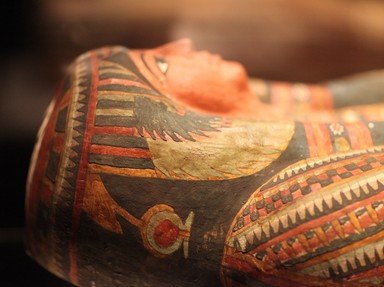Quiz Answer Key and Fun Facts
1. Nefertiti's very name evokes her unusual position in history, to say nothing of the hopes that were held of her. What is the approximate meaning of her name?
2. Nefertiti's name is similar to that of a type of jewelry she often wore as queen: long, thin, elegant nefer beads, made of a precious metal that symbolized the pharaohs' wealth and power. From what were nefer beads made?
3. Like most women in ancient Egypt, the course of Nefertiti's life would be defined by her husband. As the wife of Amunhotep - future pharaoh and thus the future incarnation of the god Ra - her position and glory would be assured. There was only one problem: young Amunhotep had a decidedly unconventional interpretation of the Egyptian religion, which would lead to his taking the new name Akhenaten. What was her husband's defining religious belief?
4. As the Great Royal Wife of Akhenaten, Nefertiti had many duties. One of these was the same as that of queen consorts throughout world history: she was to bear pharaoh's children. How many children is she known to have had?
5. Early in his reign, Nefertiti's husband Akhenaten completely overturned the old religious order. Priests and temples were stripped of their property, new temples were built, and even the capital was moved. Did Nefertiti approve of these changes?
6. As Akhenaten's reign progressed, Nefertiti's power grew, and was reflected in the art of the time. Her depictions in sculpture were shockingly similar to depictions of pharaohs! Which of these is NOT a depiction of Nefertiti that emphasizes her unusual power?
7. In Year 14 of Akhenaten's reign, Nefertiti suddenly vanished from the kingdom's records, giving rise to one of the ancient world's most fascinating mysteries. At first, archaeologists thought that she must have fallen into disgrace with her husband. Why?
8. Nefertiti disappeared from history, but she may not have disappeared from palace life. In fact, a number of archaeologists believe that she outlived her husband -- and succeeded him as pharaoh in her own right before the ascension of Tutankhamun. Under what name would she have ruled?
9. For more than three thousand years, Nefertiti, Akhenaten, and their children were forgotten. Akhenaten and his immediate successors were stricken from the official list of pharaohs; the new temples were destroyed; their tombs were, in many places, defaced. Why?
10. Since she was rediscovered by history, Nefertiti has captured the modern imagination - to the extent that she is more famous to non-Egyptologists than her husband, who only upended the entire religious and political system of a major empire for two decades. Which of these factors contributed most to her fame in the current era?
Source: Author
CellarDoor
This quiz was reviewed by FunTrivia editor
gtho4 before going online.
Any errors found in FunTrivia content are routinely corrected through our feedback system.
